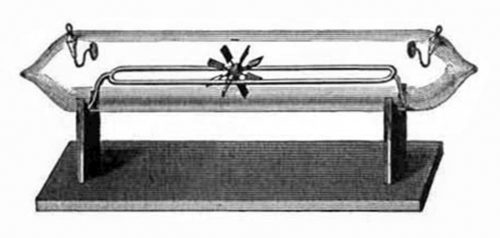4.11 阴极雷管管
章节大纲
-
How old do you think this TV is?
::你觉得这台电视几岁了?The TV set seen above is becoming harder and harder to find these days. The main reason is because they are older and based on outdated technology. The new TV sets are flat screen technology that take up less space and give better picture quality, especially with the advent of high-definition broadcasting. The technology used in the older TV sets used cathode ray tubes. A beam of electrons was sprayed to a picture tube which was treated to react with the electrons to produce an image. Similar CRT devices were used in computer monitors, now also replaced by flat screen monitors.
::上面看到的电视机越来越难找到,主要原因是它们老了,而且以过时的技术为基础。新的电视机是平板屏幕技术,占用空间较少,提供更好的图片质量,特别是随着高清晰度广播的到来。旧电视机使用的技术是阴极射线管。电束被喷到一个图象管上,用电子处理器对电子进行反应以产生图像。计算机显示器也使用了类似的CRT设备,现在也用平板屏幕显示器取代。Discovery of the Electron
::发现电子The first discovery of a subatomic particle was a result of experiments into the nature of the relationship between electricity and matter.
::首次发现亚原子粒子是实验的结果,实验涉及电力和物质之间关系的性质。Cathode Rays
::阴极射线The first cathode ray tube prototype was developed by Heinrich Geissler, a German glassblower and physicist. He used a mercury pump to create a vacuum in a tube. Geissler explored a number of techniques to remove air from the tube and to prevent leaks, as well as ways to get good connections of the wires in the tubes.
::第一个阴极射线管原型是由德国玻璃吹风者和物理学家Heinrich Geissler开发的,他用汞泵在管子中制造真空。 Geissler探索了从管子中清除空气和防止泄漏的一些技术,以及获得管子电线良好连接的途径。In 1878, Sir William Crookes , a British scientist, displayed the first cathode rays using a modification of the Geissler apparatus. His major contribution to construction of the tube was to develop ways to evacuate almost all the air from the tube. Crookes also carried out many experiments using more reliable equipment to confirm earlier finding about the properties of cathode rays. He discovered two things which supported the that the cathode ray consisted of a stream of particles:
::1878年,英国科学家William Crookes爵士利用Geissler仪器的改装,展示了第一个阴极射线。他对建造管的主要贡献是开发将几乎所有空气从管子中撤出的方法。Crookes还利用更可靠的设备进行了许多实验,以证实早些时候对阴极射线特性的发现。他发现了两件事,支持阴极射线由粒子流组成的说法:-
When an object was placed between the
cathode
and the opposite end of the tube, it cast a shadow on the glass. The shadow caused by the object indicates that particles were being blocked on their way from the cathode to the
anode
.
::当一个物体被放置在阴极和管的对面之间时,它将阴影投在玻璃上,由物体造成的阴影表明,从阴极到阳极的路上,颗粒被堵住。
-
A cathode ray tube was constructed with a small
metal
rail between the two electrodes. Attached to the rail was a paddle wheel capable of rotating along the rail. Upon starting up the cathode ray tube, the wheel rotated from the cathode towards the anode. Notice that the cathode and anode are positioned so that the rays will strike the top of the paddle wheel. Crookes concluded that the cathode ray was made of particles which must have mass.
::在两个电极之间用小铁轨建造了阴极射线管。连接铁路的是一个能够沿铁路旋转的桨轮。在启动阴极射线管时,轮子从阴极射线管向阳极旋转。注意阴极和阳极的位置,以便射线将击中桨轮的顶部。Crookes的结论是,阴极射线是由一定有质量的粒子组成的。
The cathode ray tube was first invented by Sir William Crookes. Further Research With The Crookes Tube
::与Crookes Tube进行进一步的研究Crookes' work opened the door to a number of important discoveries. Other scientists were able to demonstrate that the "cathode ray" was actually a stream of electrons . In 1897, Karl Ferdinand Braun developed the first oscilloscope, using a cathode ray tube to see an electrical pulse as it passed through the instrument. The invention of television would not have been possible without the cathode ray tube. Work with a modified system led to the discovery of X-rays in 1895 by the German physicist Wilhelm Roentgen . This simple device has led to major advances in science and technology.
::克罗科斯的作品打开了许多重要发现之门。 其他科学家能够证明“阴极射线”实际上是一串电子。 1897年,Karl Ferdinand Braun开发了第一个显微镜,用阴极射线管来观察仪器通过时的电脉冲。 没有阴极射线管,电视的发明是不可能的。 与经过修改的系统合作导致德国物理学家Wilhelm Roentgen于1895年发现了X光。这一简单装置导致了科学和技术的重大进步。Summary
::摘要-
The cathode ray tube was first invented by Sir William Crookes.
::阴极射线管是威廉·克罗克斯爵士发明的 -
Experiments showed that the rays had mass.
::实验显示射线有质量
Review
::回顾-
Who developed the first cathode ray tube?
::谁开发了第一个阴极射线管? -
What improvement did Crookes make to the cathode ray tube?
::Crookes对阴极射线管有什么改进? -
How did Crookes show there were particles being emitted?
::Crookes是怎么显示有粒子被排放的? -
What did Karl Ferdinand Braun invent?
::Karl Ferdinand Braun发明了什么? -
What did Wilhelm Roentgen invent?
::威廉·伦根发明了什么?
-
When an object was placed between the
cathode
and the opposite end of the tube, it cast a shadow on the glass. The shadow caused by the object indicates that particles were being blocked on their way from the cathode to the
anode
.


